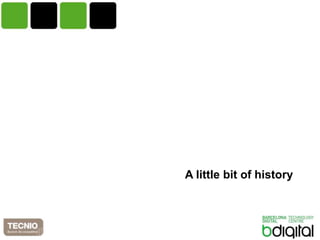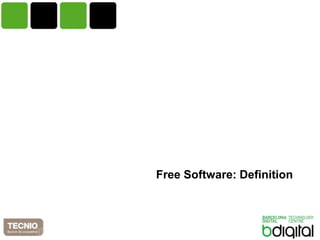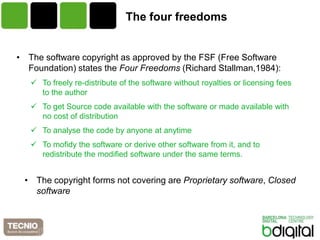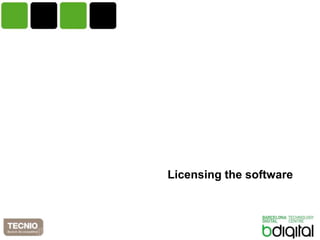Open source presentation_v03
- 1. Free Software Movement Sergi TORRELLAS eHealth Area
- 2. A little bit of history
- 3. The historical perspective In the beginning, no protection for computer software. It was de facto open source Software was seen as a complement of HW No copyright until 1980 No patenting until mid to late 1990s Could be kept a trade secret, but not effective Richard Stallman in the 1980s - founded GNU and the Free Software Foundation Open Source Movement initiated by Eric S. Raymond
- 4. The historical perspective 1974 UNIX operating system developed at Bell Labs 1976 Richard Stallman published Emacs at MIT AI Lab 1981 First MS-DOS version 1983 Richard Stallman founds the Free Software Foundation 1987 GNU project releases the initial version of GCC 1990 Beginning of graphical OS Released Windows 3.0 and OS/2. 1993 Linus Torvalds releases first version of Linux built 1995 Windows 95. Microsoft’s first fully graphical OS 1997 Debian Free Software Guidelines released 1998 Netscape releases navigator in source
- 6. The source of all: Copyright • Copyright is a legal concept It gives the creator of an original work rights to it Limited in time • Copyright also exists in Sofware Open Source model is premised on That Copyright is an intangible right; it exists independently of the code • Copyright Attaches On Creation of Original Code Copyright Notice and Registration Not Required Ownership Initially Vests in Authors or Institution
- 7. The four freedoms • The software copyright as approved by the FSF (Free Software Foundation) states the Four Freedoms (Richard Stallman,1984): To freely re-distribute of the software without royalties or licensing fees to the author To get Source code available with the software or made available with no cost of distribution To analyse the code by anyone at anytime To mofidy the software or derive other software from it, and to redistribute the modified software under the same terms. • The copyright forms not covering are Proprietary software, Closed software
- 8. Misleading software Some software companies take advantage of the open- source movement to enlarge their visibility for other purposes The general public often gets confused the multiplicity of terms: Freeware : free but no source code Shareware : not free and no source code Public Domain : without copyright Charityware : costs covered by donations
- 9. Open Source vs Free Software • The ultimate goal of FSF (Free Software Foundation) is to widespread the benefits of software for the whole mankind • The Open Source Software pursues the technological development and generation of knowledge in software by means of the available collaborative tools. • Open Source Software (OSS) is not as restrictive as the FSF. Basically, the source code must be available • The definition of OSS was based on the Debian Free Software by Bruce Perens
- 10. Let me know … … before getting asleep.
- 12. Open Source Licenses Licenses define the copyrights of the software Although the higher number of licenses, they can be grouped into three categories: Strongly protective: Can’t distribute proprietary version or directly combine (link) into proprietary work (GPL) Weakly protective: Can’t distribute proprietary version of this component, but can link into larger proprietary work (LGPL) Permissive: Can make proprietary versions (MIT, BSD-new)
- 13. Protective License : GPL GNU General Public License (“GPL”) Grants right to copy, modify and distribute Requires that source code be made available to future licenses Generally Seen as “Viral” : Any derivative work is applied with the same license Potential incompatible with patents Proprietary distribution models difficult
- 14. Weakly Protective : LGPL GNU Lesser General Public License (“LGPL”): Similar to GPL but more flexible in the terms Somewhat easier for licenses to combine the LGPL code with a separate program and distribute the combination under separate licenses Often used with Open Source Libraries that are compiled into an application program
- 15. Permissive Licenses: BSD BSD/MIT/Apache Style License: More permissive licenses; claimed to be the open- source licenses Generally allow free distribution, modifying, and license change; much like public domain software No future open source requirement Variants may include non-standard restrictions E.g., no military use – but not OSI-compliant Disclaims Warranties Subject to third-party patent claims
- 17. The cathedral and the bazaar (I) "The Cathedral and the Bazaar“ is an article published in 1997 The publication has become a prominent voice in the open source movement Raymond Co-founded the Open Source Initiative in 1998 The author unveils a “development model" through the history of the Linux kernel This model is presented as revolutionary, since it Eric S. Raymond is useful to build large systems without apparently any or few organization at all
- 18. The cathedral and the bazaar (II) The Cathedral: The “classic" model. Closed environment. Small group of leaders/developers. Only “stable” releases on Used both in classic models : waterfall, spiral Examples: Microsoft Office, Acrobat Reader, GCC The Bazaar: The model introduced by Linus Torvalds. Open environment, any person can participate There are no clear leaders However, there is a benevolent-dictator “Release early, Release often". Examples: Linux, CVS, Fetchmail
- 19. Still there? Don’t worry. We are about to finish …
- 20. Bussiness models
- 21. Bussiness Models (I) Free Software is promissing but … I need to get my bills paid. I need to pay with my mortgage I need my son to go to the kindergarten I need my health insurance How do you we make a competitive company of all that?
- 22. Bussiness Models (II) Hecker classification (Frank Hecker,1998) is the most widely accepted bussiness models by the OSI the Open Source Initiative: "Support Sellers," in which revenue comes from media distribution, branding, training, consulting, custom development "Loss Leader," where a no-charge open-source product is used to promote other traditional commercial software "Widget Frosting," for companies that are in business primarily to sell hardware but which use the open-source model "Accessorizing," for companies which distribute books, and other physical items associated
- 23. Bussiness Models (II) "Service Enabler," where open-source software is created and distributed primarily to support access to revenue-generating on- line services "Brand Licensing," in which a company charges other companies for the right to use its brand names and trademarks in creating derivative products "Sell It, Free It," where a company's software products start out their product life cycle as traditional commercial products and then are continually converted to open-source products when appropriate
- 25. Companies using open-source • IBM Corporation Uses and develops Apache and Linux; created Secure Mailer and created other software on AlphaWorks • Hewlett & Packard Uses and releases products running Linux • Sun Microsystems Uses Linux; supports some open source development efforts (Forte IDE for Java and the Mozilla web browser)
- 27. OSS Conclusions • The Free Software was envisaged by Richard Stallman and is based in four fundamental freedoms: Freedom of execution Freedom of study Freedom of redistribution Freedom of modification • Open source: supports the access to the source code which allows to a faster spread of knowledge and enlarge the community of users/developers • Open Source Software is becoming the perfect spot for both academia and industry for research technology transfer
- 28. Thank you for listening! Silence! Engineers at work




























